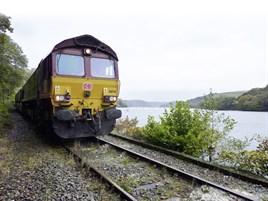Today the ‘66’ is hauling 38 CDA wagons. DB has 82 in use - these run as two rakes of 38 with four spares, with two more always left at the unloading point at St Blazey. There are always two over the pit, and Hutchinson says that the system works “as there is always one over the system”.
The operations work from Parkandillack with a loaded set that runs to Fowey (the clay is exported from Fowey). This then returns to Goonbarrow. The other set is taken from Goonbarrow and returns to Fowey. The Class 66s are fuelled once a week, and this is done on a Saturday morning at St Blazey.
There is a second Class 66 in the region, which runs to Exeter hauling wagons from Par Docks. Hutchinson explains that this engine will load over two days and also go to Treviscoe. The trains from Par Harbour run to Exeter, but in two loads because of their weight.
The limit for a Class 66 to haul over the infamous Devon banks between Plymouth and Totnes is 1,000 tonnes, so it hauls the first rake to Exeter and then returns for the second load before continuing to Newport. It is later taken to Bescot.
On the morning of RAIL’s visit, 66176 had left Fowey Docks at 0522 with its rake of wagons. It ran to Goonbarrow, which took an hour.
The plan is that it will arrive at Fowey at about 0900. It will then begin unloading at around 1000, once a complicated shunt has been completed. Unloading the 38 wagons takes three hours, and the train departs (empty) at 1350. It then runs to Goonbarrow again, is loaded, and returns at 1630.
Says Hutchinson: “There is not much waiting around. We do have some leeway for delays if they are slight. Sometimes you can run round faster in Lostwithiel loop and get out in front of a passenger train. Other times you have to wait your turn.”
At St Blazey station, which closed to passenger services in 1925, RAIL waits for 66176. The station has two platforms, while the signal box still controls the junction to the depot. In pouring rain, the ‘66’ arrives at around 0730, driven by Jeff Hancock.
At Par the train is held in a loop while a First Great Western High Speed Train arrives and collects passengers bound for London. At the other platform 66065 is shunting a rake of wagons bound for Par Harbour.
Hancock says of the AESS system: “I would not be without it. I think it is helping the noise especially if you are there for a while. It will shut down after ten minutes and it is no effort to restart it.”
He’s also happy with how quickly it can start on a cold morning.
“If you asked for anything to improve now, it is for the AESS to talk to the EM2000 , which is the brains. If something occurs to prevent the ‘66’ starting, then the AESS will keep trying and that will spin the starting motor which eventually will burn out. That flattens the battery.” Hancock speaks of the field generator circuit breakers tripping, and the computer didn’t know how many times the locomotive had attempted to start.















Login to comment
Comments
No comments have been made yet.